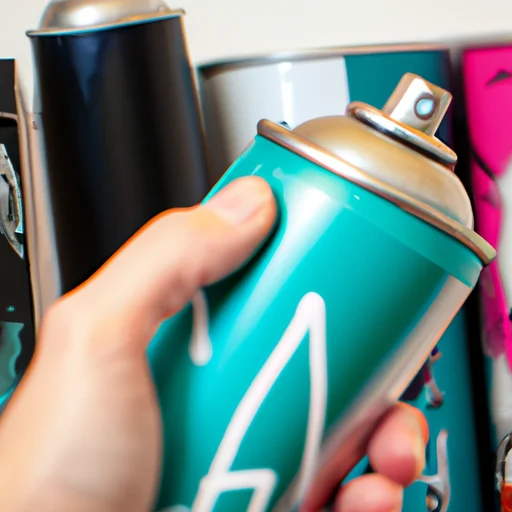If you’ve ever tried your hand at spray painting, you’ll know how tricky it can be to control the overspray. That fine mist of paint has a sneaky way of finding its way onto everything nearby, leaving behind a messy aftermath. But fear not, for we’ve got you covered with some foolproof tips on how to protect those precious surrounding surfaces from unwanted overspray. From simple masking techniques to clever DIY barriers, you’ll discover an array of easy and effective solutions that will keep your surroundings pristine and your painting ventures stress-free. Say goodbye to those pesky splatters and hello to a flawlessly spray-painted world!
How To Protect Surrounding Surfaces From Overspray?
Table of Contents
Choosing the Right Location
When it comes to painting, choosing the right location is essential to ensure that overspray does not damage surrounding surfaces. Identifying a suitable area for your painting project is the first step in protecting against overspray. This includes selecting a space that is spacious enough to accommodate your equipment and allows for proper ventilation.
Considering climate and weather conditions is another crucial factor in selecting the right location. Extreme temperatures or high humidity can affect the drying process of the paint and increase the risk of overspray. Therefore, it is important to choose a location with favorable weather conditions that will support a successful paint job.
Ensuring proper ventilation is vital to prevent overspray from accumulating in the air and settling on surfaces. Choose a location that allows for good airflow, or consider using fans or opening windows and doors to promote air circulation. By paying attention to these aspects, you can create an ideal environment for your painting project and minimize the risk of overspray.
Preparing the Surrounding Surfaces
Before you begin painting, it is crucial to properly prepare the surrounding surfaces to protect them from overspray. Cleaning and clearing the area is the first step in this process. Remove any furniture, décor, or other items that could be damaged or obstructed during the painting process. This will not only protect your belongings but also provide a clear workspace for a smooth and efficient project.
Covering delicate surfaces is another effective way to safeguard against overspray. Utilize drop cloths or plastic sheeting to cover furniture, floors, and any other surfaces that could be affected by the paint. By providing a physical barrier, you can prevent overspray from settling on these sensitive surfaces and save yourself from unnecessary cleaning or repairs.
It is also important to remove loose items from the area before painting. Objects such as loose screws, nails, or tools can cause accidents or errors during the painting process. By ensuring a clutter-free environment, you can focus on your project without worrying about potential mishaps that could lead to overspray on surfaces.
Ensuring Proper Equipment Usage
Using the right equipment is essential in preventing overspray from affecting surrounding surfaces. One important consideration is to use correct spray tips for your painting equipment. Different tips offer different spray patterns, so selecting the appropriate one for your specific project will help control the amount of overspray produced. This will allow you to direct the paint where you want it, reducing the risk of overspray on unwanted surfaces.
Adjusting pressure and flow settings on your equipment is another crucial step in minimizing overspray. By finding the optimal balance, you can control the amount of paint that is released during each spray. This will help prevent excessive overspray and ensure that the paint is applied evenly and accurately to your intended surfaces.
Maintaining control and distance from the surfaces you are painting is vital in preventing overspray. Keep a consistent distance from the surface and maintain a steady hand to avoid excessive spray width. By practicing proper technique and being mindful of your movements, you can minimize the risk of overspray and achieve professional-looking results.
Using Protective Materials
To further protect surrounding surfaces from overspray, utilizing protective materials is essential. Applying drop cloths or plastic sheeting is an effective way to create a barrier between the paint and the surfaces you want to protect. This will catch any overspray or drips, preventing them from reaching the underlying surfaces.
Using masking tape for edges and trim is also a valuable technique in preventing overspray. By carefully applying tape along the edges of surfaces or between different color areas, you can create clean lines and prevent paint from bleeding onto unwanted areas. This will give your paint job a polished and precise finish.
Painter’s paper is another option for protecting surfaces during a painting project. It is thicker and more durable than regular paper, providing an extra layer of protection against overspray. Utilize painter’s paper on floors, walls, or any other surface that may be at risk of overspray.
Consideration for Windows and Glass
Windows and glass surfaces require special attention to protect them from overspray. Applying temporary window protection such as window film or plastic sheeting can effectively shield glass surfaces from overspray. This will ensure that the paint does not adhere to the glass, making cleanup much easier and minimizing potential damage.
Painter’s plastic is another useful tool for protecting glass surfaces during painting. Cut the plastic to fit the size of the windows or glass areas and securely tape it in place. This will create a barrier between the paint and the glass, preventing overspray from sticking and allowing for hassle-free removal after the project is complete.
When masking glass surfaces, it is important to use proper techniques to achieve clean lines and avoid overspray. Apply painter’s tape along the edges of the glass, ensuring it adheres tightly and creating a tight seal. This will prevent paint from seeping through and keep the glass surfaces free from unwanted paint.
Covering and Protecting Furniture
Furniture is often susceptible to damage from overspray during painting projects. To protect your furniture, it is advisable to remove or relocate fragile items to a safe area away from the painting zone. This will minimize the risk of accidental overspray and prevent potential damage to your valued possessions.
Using plastic covers or fabric drop cloths is another effective way to shield furniture from overspray. Covering your furniture completely with these protective materials creates a physical barrier that prevents the paint from settling on the surfaces. This ensures that your furniture remains clean and intact throughout the painting process.
When it comes to upholstery and wooden surfaces, special care should be taken to ensure their protection. Utilize specific upholstery protectors or plastic covers designed for furniture to safeguard the upholstery from overspray. For wooden furniture, applying a layer of painter’s tape on exposed wood surfaces will create a barrier, preventing the paint from adhering to the wood and making cleanup easier.
Preventing Overspray on Floors
Preventing overspray from reaching the floor is crucial in maintaining a clean and hassle-free painting project. Start by thoroughly cleaning and sweeping the floor to remove any dust or debris that could potentially mix with the paint. This will create a smooth surface and minimize the risk of unwanted particles ending up in the paint.
Using canvas or plastic to cover the floor is an effective way to protect it from overspray. Lay down a drop cloth or securely tape plastic sheeting to the floor, ensuring that it covers the entire area that could be affected by overspray. By creating this barrier, you can prevent the paint from seeping through and damaging the floor.
In some cases, applying multiple layers of protective material may be necessary, especially if you are working with spray equipment that produces a significant amount of overspray. Adding additional layers of canvas or plastic will provide extra protection and help contain any overspray that may escape from the intended surface.
Considering Outdoor Surfaces
Outdoor surfaces require special attention when protecting against overspray. If you have plants or landscaping in the vicinity, it is important to protect them from the paint. Cover plants with mesh screens to create a barrier that prevents overspray from settling on leaves or flowers. This will preserve the beauty of your outdoor space and prevent any potential damage to your vegetation.
If you have outdoor furniture or fixtures, consider covering them with drop cloths or plastic sheeting. This will protect them from overspray and ensure that they remain clean and unharmed throughout the painting process. By taking these extra precautions, you can enjoy a pristine outdoor area once the painting project is complete.
Using mesh screens for maximum protection is highly recommended when working with outdoor surfaces. By attaching mesh screens around the work area, you can create a barrier that prevents overspray from drifting and affecting nearby surfaces. This will ensure that the paint is applied only to the intended surfaces and minimize the risk of overspray on outdoor elements.
Managing Overspray During Application
Managing overspray during the painting process is crucial to keeping surrounding surfaces protected. To do this, maintain proper spraying techniques such as holding the spray gun at the correct angle and distance from the surface. This will help you control the spray pattern and reduce the risk of overspray reaching unwanted areas.
Working in controlled sections is another effective way to manage overspray. Instead of attempting to cover large areas all at once, divide the project into smaller, manageable sections. This will allow you to focus on each area individually, ensuring proper coverage without the risk of overspray spreading beyond the intended surfaces.
Using dry-fall paints in certain settings can also help mitigate overspray concerns. Dry-fall paints are designed to dry quickly, forming a powdery residue that can be easily collected and cleaned up without adhering to surfaces. Using these types of paints in enclosed spaces or areas with a high risk of overspray can minimize the impact on surrounding surfaces and simplify the cleanup process.
Cleaning Overspray
Even with the best precautions in place, overspray may still occur. Promptly addressing any overspray is crucial to prevent it from permanently adhering to surfaces. The method for removing overspray will vary depending on the surface it has landed on.
When dealing with overspray on walls or non-porous surfaces, using appropriate cleaning solutions is important. Test a small, inconspicuous area first to determine the effectiveness and safety of the cleaning solution you plan to use. Apply the solution to a clean cloth or sponge and gently wipe away the overspray, being careful not to damage the surface underneath.
For overspray on glass surfaces, using a glass cleaner or a mixture of vinegar and water can effectively remove it. Spray the cleaner onto a cloth or paper towel, and gently wipe the glass to remove the overspray. Take care not to scratch the glass and ensure that it is thoroughly cleaned for a streak-free finish.
If overspray has landed on fabrics or upholstery, it is recommended to consult professional cleaners to properly remove it. They have the expertise and specialized tools to safely and effectively remove overspray from these delicate surfaces without causing any damage.
By utilizing appropriate cleaning solutions and promptly addressing overspray, you can minimize any potential damage and restore the affected surfaces to their original condition.
In conclusion, protecting surrounding surfaces from overspray requires careful planning, preparation, and implementation of proper techniques. By choosing the right location, preparing the surrounding surfaces, ensuring proper equipment usage, using protective materials, considering windows and glass, covering and protecting furniture, preventing overspray on floors, considering outdoor surfaces, managing overspray during application, and cleaning overspray promptly, you can successfully shield surrounding surfaces and achieve a professional and clean paint job.
With these guidelines in mind, you can confidently embark on your painting project and enjoy the end result without the worry of overspray affecting your surroundings.

Upgrade Your Painting Game
Explore our Introduction To The Best Paint Sprayers guide to take your projects to the next level!

